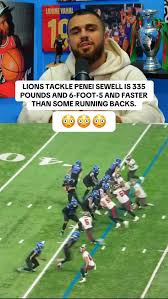At 6 feet 5 inches and 335 pounds, Penei Sewell is quicker than some running backs—a statement that sounds almost unbelievable until you actually watch him move. The Detroit Lions’ offensive tackle is redefining what it means to be a modern lineman in the National Football League. His rare combination of size, strength, and agility makes him not just an anchor for the Lions’ offense, but also one of the most complete athletes in professional football. There are few players of his stature who can move with such fluidity, explode off the line with so much power, and adjust in open space as if he were built like a tight end. What Sewell brings to the field is a level of athleticism that’s so far beyond ordinary that even some running backs have admitted they envy how fast and balanced he looks at that size.
When Penei Sewell entered the NFL as the seventh overall pick in the 2021 Draft, expectations were already sky-high. Coming out of Oregon, he was described as a “generational talent” on the offensive line—a player with freakish potential who could change the entire identity of a franchise. But what has set Sewell apart isn’t just his strength or technique; it’s his ability to move like someone half his weight. Offensive linemen are supposed to be bruisers, immovable walls who protect the quarterback and create lanes for running backs. Sewell does all that, but with a touch of athletic grace that almost seems out of place for someone his size. Watching him pull around the edge on a run play or sprint downfield to block for a receiver is like watching a bear dance ballet—it’s powerful, elegant, and terrifying all at once.
The Lions’ coaching staff quickly realized they had something special on their hands. Head coach Dan Campbell, known for his love of gritty, physically dominant players, has often described Sewell as a “tone-setter.” In Campbell’s culture of toughness and aggression, Sewell has become the embodiment of Detroit’s resurgence. His athleticism allows the team to expand its playbook. Plays that would normally be too risky for a traditional lineman—like long-developing screens or outside runs—become viable options because Sewell can keep up. His quick first step and incredible acceleration allow him to get into position faster than defenders expect. For a 335-pound man to mirror an edge rusher’s movements or get out ahead of a running back is a rare sight, and Sewell does it so naturally that it almost feels unfair.
There’s also a psychological element to his dominance. Defenders who line up against him often underestimate his ability to recover and move laterally. They see a big frame and assume they can beat him with speed, only to find out that he moves like a linebacker. Sewell’s footwork is as smooth as it is violent—he’s constantly balanced, with an uncanny sense of timing and leverage. That combination of technique and athletic ability makes him nearly impossible to beat cleanly. In fact, many defensive ends who have faced him have publicly praised him as one of the toughest matchups in the league. What makes him even scarier is that he’s still improving. At just 24 years old, Sewell has yet to reach his physical and mental peak as a player.
Part of Sewell’s athleticism can be traced to his upbringing. Born in American Samoa and raised in a football-loving family, Penei was built for the game almost from birth. His father, Gabriel, was a coach who emphasized fundamentals and conditioning from a young age. His brothers have all played football at high levels, including his older brother Nephi, who played at Utah, and younger brother Noah, a linebacker at Oregon who’s now in the NFL with the Chicago Bears. The Sewell family is steeped in competition and physical training, and Penei’s rare blend of power and agility is a product of both genetics and relentless preparation. Even as a teenager, coaches at Oregon remarked that he moved “like a skill position player trapped in a lineman’s body.”
That natural ability was evident from the moment he arrived at Oregon. As a freshman, Sewell started seven games before suffering an injury, but in those appearances, he completely dominated experienced defenders. His combination of strength and athleticism made him an instant standout. By his sophomore year, he was nearly untouchable. He won the Outland Trophy, awarded to the nation’s best interior lineman, becoming the first sophomore to do so in nearly four decades. Scouts noted his balance, hand placement, and quickness off the snap. Many described him as the closest thing to a “perfect prospect” they had seen in years. What’s even more impressive is that Sewell sat out the 2020 season due to the COVID-19 pandemic, yet his draft stock never dipped—testament to how highly regarded his skills were.
When he transitioned to the NFL, the physical adjustment was minimal. Sewell didn’t just survive against elite competition; he thrived. As a rookie, he immediately became one of Detroit’s best players. The jump from college to professional football often exposes flaws in young linemen—speed, technique, or stamina—but Sewell’s athleticism closed that gap almost instantly. He switched from left tackle to right tackle early in his career without missing a beat, a move that would derail most young players. But Sewell’s body control and awareness made the transition seamless. It was as if his instincts adapted in real-time. Whether it’s adjusting to a bull rush, recovering from a missed step, or pulling across the line to block a safety, Sewell’s quickness sets him apart.
There are clips circulating online that show just how absurd his mobility is. In one game, Sewell sprinted nearly 40 yards downfield to make a block on a screen pass—an image that stunned both fans and analysts. His stride length and acceleration made him look like a tight end rather than a tackle. In another instance, he pancaked a defender on one play, then immediately got up and led a block on the next, showing not just physical dominance but an energy level that defies his size. He doesn’t just move quickly; he moves with intent, always seeking the next target, always aware of how to create space for his teammates.
That mobility is also what makes him such a weapon in Detroit’s offense. Offensive coordinator Ben Johnson has built one of the most creative and balanced offenses in the league, and Sewell is central to its success. He allows the Lions to dictate tempo and strategy. With Sewell on the edge, the Lions can run stretch plays, complex misdirections, and bootlegs with confidence, knowing that their right tackle can seal off defenders at any level of the field. His ability to block in open space opens up possibilities that few other teams have. It’s not just about protection anymore—it’s about using athleticism as an offensive weapon.
What’s particularly impressive about Sewell is how he blends brute strength with refined technique. His upper body power allows him to completely neutralize even the most explosive pass rushers, while his quick feet ensure he rarely gets caught flat-footed. Most offensive linemen excel in one area—either they’re power-based maulers or agile technicians—but Sewell is both. When he locks onto a defender, it’s over. His grip strength and leverage make it nearly impossible for opponents to disengage. When you combine that with his ability to move in open space, you get a player who’s as dominant in the run game as he is in pass protection.
Teammates often rave about how much Sewell loves the game. He’s not just a physical specimen—he’s a competitor through and through. He brings energy to every snap, every huddle, every practice. When he pancakes a defender or clears a path for a big run, his celebrations are full of raw emotion, feeding the team’s collective intensity. That fire is part of what has made the Lions such a dangerous and motivated unit under Dan Campbell. They feed off Sewell’s passion as much as they rely on his skill. He’s become not just a cornerstone of the offense but a leader by example, one whose work ethic and energy lift those around him.
In many ways, Penei Sewell represents the future of the offensive line position. The game has evolved—defensive ends and linebackers are faster, more explosive, and more versatile than ever. To counter that, teams need linemen who can move just as well, who can adapt and adjust at lightning speed. Sewell is the prototype of that evolution: the rare big man who can play with the agility and coordination of a skill player. Watching him move is watching the next generation of football unfold before your eyes. He’s proof that size and speed are no longer separate categories—they can coexist in one terrifyingly effective athlete.
As the Lions continue their rise as one of the NFC’s most balanced and dangerous teams, Sewell’s importance can’t be overstated. Quarterback Jared Goff’s confidence in the pocket, the running backs’ success in breaking long runs, and the efficiency of Detroit’s offensive system all trace back to the stability and dominance of their offensive line. And at the heart of that line is Sewell, whose physical gifts and competitive drive make him the ultimate protector. He’s not just quick for his size—he’s redefining what being “quick” even means for a lineman.
In the years to come, Sewell’s name will likely be mentioned alongside some of the all-time greats. His youth and continuous improvement suggest that multiple Pro Bowls, All-Pro honors, and even Hall of Fame discussions are on the horizon if he stays healthy. What makes him even more compelling is how much he enjoys the grind. He’s constantly studying film, refining technique, and improving balance and hand usage. That commitment to excellence, combined with his freakish athleticism, gives him a ceiling that few linemen in history have ever approached.
At 6 feet 5 inches and 335 pounds, Penei Sewell moves like a running back, blocks like a bulldozer, and leads like a warrior. He’s a once-in-a-generation kind of athlete, one whose speed, power, and intelligence make him a cornerstone not just for the Detroit Lions, but for the modern evolution of football itself. Watching him play is watching the sport’s future—where power meets precision, and where giants move like sprinters. In a league built on speed and strength, Sewell stands at the intersection of both, proving that even at 335 pounds, quickness isn’t just about size—it’s about greatness.



